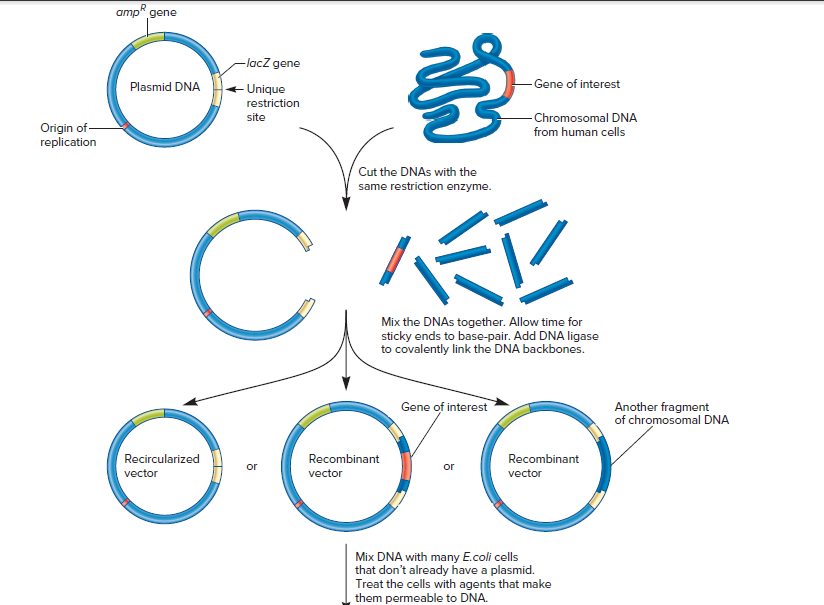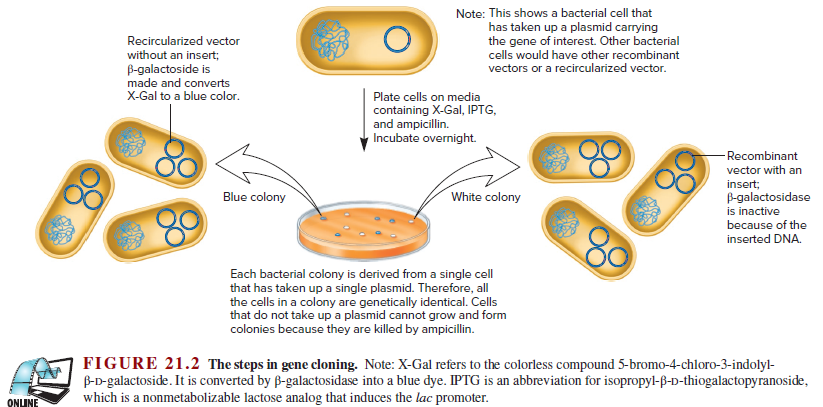amp" gene -lacZ gene -Gene of interest Plasmid DNA - Unique restriction - Chromosomal DNA site Origin of- replication from human cells Cut the DNAS with the same restriction enzyme. Mix the DNAS together. Allow time for sticky ends to base-pair. Add DNA ligase to covalently link the DNA backbones. Gene of interest Another fragment of chromosomal DNA Recircularized Recombinant Recombinant or or vector vector vector Mix DNA with many E.coli cells that don't already have a plasmid. Treat the cells with agents that make them permeable to DNA. Note: This shows a bacterial cell that has taken up a plasmid carrying the gene of interest. Other bacterial cells would have other recombinant Recircularized vector without an insert; B-galactoside is made and converts X-Gal to a blue color. vectors or a recircularized vector. Plate cells on media containing X-Gal, IPTG, and ampicillin. Incubate overnight. Recombinant vector with an insert; Blue colony White colony B-galactosidase is inactive because of the inserted DNA. Each bacterial colony is derived from a single cell that has taken up a single plasmid. Therefore, all the cells in a colony are genetically identical. Cells that do not take up a plasmid cannot grow and form colonies because they are killed by ampicillin. FIGURE 21.2 The steps in gene cloning. Note: X-Gal refers to the colorless compound 5-bromo-4-chloro-3-indolyl- B-D-galactoside. It is converted by B-galactosidase into a blue dye. IPTG is an abbreviation for isopropyl-ß-D-thiogalactopyranoside, which is a nonmetabolizable lactose analog that induces the lac promoter. ONLUNE
amp" gene -lacZ gene -Gene of interest Plasmid DNA - Unique restriction - Chromosomal DNA site Origin of- replication from human cells Cut the DNAS with the same restriction enzyme. Mix the DNAS together. Allow time for sticky ends to base-pair. Add DNA ligase to covalently link the DNA backbones. Gene of interest Another fragment of chromosomal DNA Recircularized Recombinant Recombinant or or vector vector vector Mix DNA with many E.coli cells that don't already have a plasmid. Treat the cells with agents that make them permeable to DNA. Note: This shows a bacterial cell that has taken up a plasmid carrying the gene of interest. Other bacterial cells would have other recombinant Recircularized vector without an insert; B-galactoside is made and converts X-Gal to a blue color. vectors or a recircularized vector. Plate cells on media containing X-Gal, IPTG, and ampicillin. Incubate overnight. Recombinant vector with an insert; Blue colony White colony B-galactosidase is inactive because of the inserted DNA. Each bacterial colony is derived from a single cell that has taken up a single plasmid. Therefore, all the cells in a colony are genetically identical. Cells that do not take up a plasmid cannot grow and form colonies because they are killed by ampicillin. FIGURE 21.2 The steps in gene cloning. Note: X-Gal refers to the colorless compound 5-bromo-4-chloro-3-indolyl- B-D-galactoside. It is converted by B-galactosidase into a blue dye. IPTG is an abbreviation for isopropyl-ß-D-thiogalactopyranoside, which is a nonmetabolizable lactose analog that induces the lac promoter. ONLUNE
Biochemistry
6th Edition
ISBN:9781305577206
Author:Reginald H. Garrett, Charles M. Grisham
Publisher:Reginald H. Garrett, Charles M. Grisham
Chapter28: Dna Metabolism: Replication, Recombination, And Repair
Section: Chapter Questions
Problem 17P
Related questions
Question
Explain the role of the gene that is the selectable marker gene in this experiment.

Transcribed Image Text:amp" gene
-lacZ gene
-Gene of interest
Plasmid DNA
- Unique
restriction
- Chromosomal DNA
site
Origin of-
replication
from human cells
Cut the DNAS with the
same restriction enzyme.
Mix the DNAS together. Allow time for
sticky ends to base-pair. Add DNA ligase
to covalently link the DNA backbones.
Gene of interest
Another fragment
of chromosomal DNA
Recircularized
Recombinant
Recombinant
or
or
vector
vector
vector
Mix DNA with many E.coli cells
that don't already have a plasmid.
Treat the cells with agents that make
them permeable to DNA.

Transcribed Image Text:Note: This shows a bacterial cell that
has taken up a plasmid carrying
the gene of interest. Other bacterial
cells would have other recombinant
Recircularized vector
without an insert;
B-galactoside is
made and converts
X-Gal to a blue color.
vectors or a recircularized vector.
Plate cells on media
containing X-Gal, IPTG,
and ampicillin.
Incubate overnight.
Recombinant
vector with an
insert;
Blue colony
White colony
B-galactosidase
is inactive
because of the
inserted DNA.
Each bacterial colony is derived from a single cell
that has taken up a single plasmid. Therefore, all
the cells in a colony are genetically identical. Cells
that do not take up a plasmid cannot grow and form
colonies because they are killed by ampicillin.
FIGURE 21.2 The steps in gene cloning. Note: X-Gal refers to the colorless compound 5-bromo-4-chloro-3-indolyl-
B-D-galactoside. It is converted by B-galactosidase into a blue dye. IPTG is an abbreviation for isopropyl-ß-D-thiogalactopyranoside,
which is a nonmetabolizable lactose analog that induces the lac promoter.
ONLUNE
Expert Solution
This question has been solved!
Explore an expertly crafted, step-by-step solution for a thorough understanding of key concepts.
This is a popular solution!
Trending now
This is a popular solution!
Step by step
Solved in 2 steps

Knowledge Booster
Learn more about
Need a deep-dive on the concept behind this application? Look no further. Learn more about this topic, biology and related others by exploring similar questions and additional content below.Recommended textbooks for you

Biochemistry
Biochemistry
ISBN:
9781305577206
Author:
Reginald H. Garrett, Charles M. Grisham
Publisher:
Cengage Learning

Biology 2e
Biology
ISBN:
9781947172517
Author:
Matthew Douglas, Jung Choi, Mary Ann Clark
Publisher:
OpenStax

Biochemistry
Biochemistry
ISBN:
9781305577206
Author:
Reginald H. Garrett, Charles M. Grisham
Publisher:
Cengage Learning

Biology 2e
Biology
ISBN:
9781947172517
Author:
Matthew Douglas, Jung Choi, Mary Ann Clark
Publisher:
OpenStax